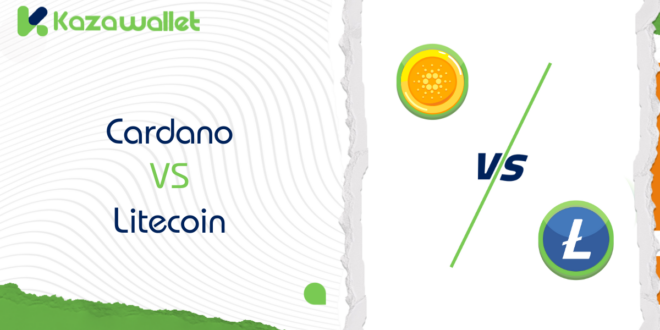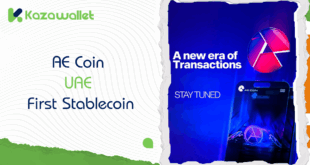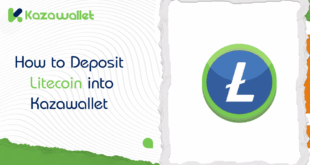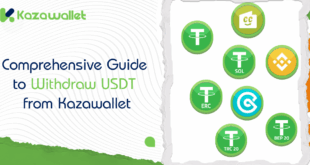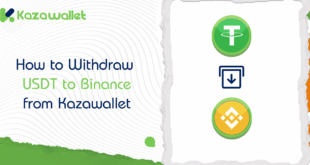Have you ever asked yourself why there’s so much variation in cryptocurrencies out there?
There are those that are seeking to transform how financial technology works with new-age innovations and others who are seeking to make what already exists more efficient.
Here, we will discuss Cardano vs Litecoin, and how these differences can help us gain a clearer picture of the larger landscape of blockchain, regardless of whether you’re investing for what’s coming down the road or simply seeking a usable tool for everyday purposes.
What is Cardano?

Cardano is not only a cryptocurrency but it’s also a multi-level technology platform to tackle existing issues within the field of blockchain.
It is an ambitious project that was started in 2017, with a goal to integrate high performance and high security based firmly upon scientific foundations.
A distinguishing feature of Cardano is its utilization of the “Proof of Stake” (PoS) consensus mechanism, which is significantly less energetically expensive than others, including “Proof of Work” (PoW).
Its native token, ADA, is not only an instrument for payments, it is also an incentive for actors within the blockchain system.
The platform provides a flexible framework that accommodates decentralized applications (dApps) and smart contract support, which is a draw for both business owners and developers.
What is Litecoin?

One of the longest-established and most popular cryptocurrencies, Litecoin was created by Charlie Lee, a former software engineer at Google, back in 2011.
Litecoin was specifically conceived as an enhanced version of Bitcoin, with the priority being quicker transaction times and reduced transaction costs.
Although Litecoin is based on the same technology as Bitcoin, it employs the “Scrypt” algorithm, not “SHA-256.”
It is thus less power-consuming and relatively simpler to mine. Litecoin processes confirmations at around 2.5 minutes, as opposed to 10 for Bitcoin.
Bitcoin vs Litecoin: Which is Better for Investment?
Cardano vs Litecoin: The Difference Between Cardano and Litecoin

Prior to delving into the details, it is crucial to appreciate that these two currencies have different backgrounds and different purposes.
This inherent contrast is expressed through a number of features, for instance, their functionality, technology, stability, supply, and usage. These are the differences between Cardano and Litecoin:
Primary Purpose
Cardano aims to offer a comprehensive ecosystem that supports decentralized applications and smart contracts. In contrast, Litecoin primarily serves as a fast and cost-effective payment method.
You could say Cardano looks to the future with a broader vision, aiming to revolutionize financial infrastructure, while Litecoin stays true to its traditional role as the “silver” to Bitcoin’s “gold.”
Technology and Stability
The differences between Cardano and Litecoin are technological. Cardano leans on cutting-edge scientific research, setting it apart from many other cryptocurrencies.
The platform adopts a gradual approach to development, where every step undergoes thorough review and refinement before implementation.
On the other hand, Litecoin relies on tried-and-tested technologies, ensuring smoother day-to-day operations. However, its focus on speed and cost may come at the expense of innovation in other areas.
Supply and Economics
The circulating supply plays a significant role in determining a currency’s value. Cardano has a maximum supply of 45 billion ADA, creating a balanced economic system.
Litecoin, meanwhile, is capped at 84 million LTC—double the number of Bitcoin’s supply. This difference directly impacts each currency’s inflation policy and market value.
Use Cases
One of the differences between Cardano and Litecoin is that Cardano is mainly used for decentralized applications and smart contracts, making it popular among developers and enterprises.
Litecoin, however, is primarily utilized as a payment method and for low-cost, rapid transactions.
Decentralization and Adoption
In decentralization, Cardano counts on a large group of users that contribute to decisions through governance processes. It is thereby more decentralized than Litecoin, which bases its mining on a relatively centralized system.
In adoption, Litecoin retains an advantage through its reputation and history, as well as its entrenched market presence. All that being said, Cardano is gaining traction with institutions and state actors, which will power its future growth.
Cardano vs Solana: Which is Better for Investment?
Cardano vs Litecoin: Risks Involved

Despite their advantages, neither Cardano nor Litecoin is free from risks:
Risks with Cardano (ADA)
- Market Volatility: Like other cryptocurrencies, ADA’s price is highly sensitive to various factors, including project-related news and updates and broader market trends.
- Scalability Challenges: Although Cardano aims to solve scalability issues, success isn’t guaranteed. The network might struggle with high transaction volumes, leading to higher fees or slower processing times.
- Security Concerns: While PoS is more sustainable than PoW, no system is completely immune to attacks. Unexpected protocol vulnerabilities could expose the network to breaches or compromise user funds.
- Regulatory Uncertainty: Many countries lack clear regulations for cryptocurrencies like ADA. Changes in laws could restrict usage or even ban the currency entirely, hindering global expansion.
Risks with Litecoin (LTC)
- Leadership Trust Issues: In December 2017, Charlie Lee sold his entire stake in Litecoin to avoid conflicts of interest. While he claimed the move was aimed at enhancing transparency, selling out entirely raised doubts about his commitment to the project.
- Intense Competition: Litecoin isn’t alone in its niche. If Bitcoin improves its transaction speeds or lowers costs, Litecoin could lose its edge as the faster, cheaper alternative.
- Regulatory Instability: Governments worldwide are still figuring out how to regulate cryptocurrencies. Any new laws or restrictions could disrupt Litecoin’s functionality or legality.
- Wealth Concentration: A significant portion of Litecoin is owned by a small group of individuals, increasing the risk of market manipulation through large buy or sell orders.
- Security Vulnerabilities: Although Litecoin uses blockchain technology, it’s relatively less secure than Bitcoin and more susceptible to attacks if a single entity gains majority mining power.
How to Mitigate These Risks?
To reduce risks, users can take steps such as enabling two-factor authentication on digital accounts and using secure wallets like Kazawallet.
Kazawallet offers a seamless and safe way to manage Litecoin, simplifying buying, storing, depositing, and withdrawing funds while avoiding untrustworthy platforms.
Final Thoughts:
At its core, Cardano and Litecoin symbolize the sheer variety of the world of cryptocurrencies. While one is an advocate for innovation and revolution, the other offers simple, pragmatic fixes.
The actual question is not which one is better across the board—it’s which one is closer to your individual requirements.
Whether you are investing in the next generation of tech or simply need an everyday tool, knowing the differences between Cardano and Litecoin is the first step to making an informed choice.
 Blog Kazawallet
Blog Kazawallet
